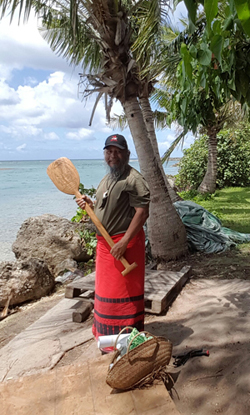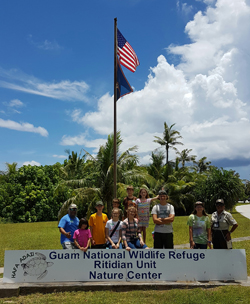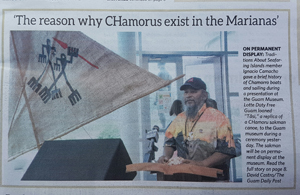Ignacio (Nash) R. Camacho, Traditional Navigator
 Ignacio (Nash) R. Camacho is a native CHamoru, born on the Pacific island Guam (Guahan), a US Territory in the Marianas Islands. He returned to live permanently after a long absence, having served in and retired from the United States Air Force. Although his military specialty was in Electronics Communication, he found a resurgence in political and social changes on his native island, prompting him to change his life course toward preservation of its indigenous cultural and natural resources. He is a 20 year member of the Volunteer Conservation Officer Program at Andersen Air Force Base, which, while gave him an active part in hunting and ungulate management for the preservation of critical habitat for endangered native flora and fauna. He became a subject matter expert on the many cultural sites throughout the base, and became a jungle guide for many scientific teams conducting research in anthropology and other disciplines. He was instrumental in the discovery and preservation efforts in the last of 14 extant Spanish-Era ovens, the final one located through his efforts at the air base.
Ignacio (Nash) R. Camacho is a native CHamoru, born on the Pacific island Guam (Guahan), a US Territory in the Marianas Islands. He returned to live permanently after a long absence, having served in and retired from the United States Air Force. Although his military specialty was in Electronics Communication, he found a resurgence in political and social changes on his native island, prompting him to change his life course toward preservation of its indigenous cultural and natural resources. He is a 20 year member of the Volunteer Conservation Officer Program at Andersen Air Force Base, which, while gave him an active part in hunting and ungulate management for the preservation of critical habitat for endangered native flora and fauna. He became a subject matter expert on the many cultural sites throughout the base, and became a jungle guide for many scientific teams conducting research in anthropology and other disciplines. He was instrumental in the discovery and preservation efforts in the last of 14 extant Spanish-Era ovens, the final one located through his efforts at the air base.
He became a member of TASI (Traditions About Seafaring Islands), the oldest “Guma Sakman” (Canoe House), which had built a full scale “Flying Proa,” the first built by CHamorus on Guam since the practice was lost during Spanish Occupation. This Sakman, named Saina is the flagship of all outrigger sailing canoes on Guam. Apprenticing under the late “Pwo” (Master Navigator) Manny Sikau from Chuuk. Mr. Camacho has since become a Board Member of TASI, having refurbished and built several types of traditional outrigger canoes for training, sailing, as well as exhibit pieces. He has since become the principle Navigator for Saina. In embracing this new art, he has also expanded his teaching in building and sailing, as well as other aspects of cultural revival in history, language, and traditional arts. He facilitated the completion of the first CHamoru language Seafaring Lexicon as well as the inaugural Pacific Islands Canoe Summit. He was co-c hairman of Traditional Seafaring Discipline during the 12th Festival of Pacific Arts held on Guam in 2016. He also trained aboard an outrigger canoe built of modern materials after the traditional Sakman of the Marianas. This Sakman, the Ana Varu (named after one of the pillars of Heaven in Polynesia) was built in Northern Germany, where he trained aboard the ship in the Baltic Sea Region. The Ana Varu is part of the Rapa Nui Experiment, founded by world renowned circumnavigator Burghard Pieske to trace the migration of peoples from Asia through Micronesia, Melanesia, and Polynesia, ending at Rapa Nui, Easter Island. Mr. Camacho was the Non-Instrument Traditional N avigator, who along with Pieske, were to sail the longest and oldest leg of Pacific migration from Taiwan to Guam. Due to 15 days of gale force winds, they managed to sail the same distance, but made landfall in the Republic of Palau.
avigator, who along with Pieske, were to sail the longest and oldest leg of Pacific migration from Taiwan to Guam. Due to 15 days of gale force winds, they managed to sail the same distance, but made landfall in the Republic of Palau.
Mr. Camacho continues to be active as a certified Guide for the US Fish and Wildlife Service Refuge at Ritidian Point, Guam, leading hundreds of guests through historic Pre-Latte Era village and Pictograph Cave tours. He is also a member of the new Guam and CHamoru Educational Facility/The Palomo Guam Museum Review Committee, as well as designer and builder for the Permanent Exhibit there.
He remains a staunch advocate for and mentor to the various groups promoting the preservation, protection, and use of the CHamoru language and all aspects of an accurate recounting of Guam’s 4000 year old history, and the traditions and culture of the Native Inhabitants of Guam. He is active in efforts to address the Decolonization, Political Self Determination of his Island and People.
What led you to your field?  A desire to preserve my country’s cultural and natural resources. After retiring from a highly technical field in the United States Air Force, I wanted to live a more organic, spiritually driven life. In returning to my home on Guam, I rediscovered my love for my people, our history, and our future. I joined (and still am active) a Volunteer Conservation Officer Program at Andersen to help preserve endangered animals and their habitat. I stumbled on an apprenticeship program with Traditions About Seafaring Islands (TASI) a nonprofit organization dedicated to learning about, practicing, and preserving Traditional Seafaring and Navigation. I learned under the now late Master Navigator (PWO) Manny Sikau from Pulowat Island in Chuuk, the Federated States of Micronesia. Since then, I have built, designed, repaired, restored, and taught about the iconic outrigger canoes of Guam and the Marianas. I have also become a cultural practitioner and advocate for the preservation of local resources, the CHamoru language, and a historical study of our 4000 year old culture. I became certified as a Guide at the US Fish and Wildlife Service Wildlife Refuge at Ritidian, Guam, leading hundreds of visitors into the rediscovered ancient Latte Period village and Pictograph Cave areas.
A desire to preserve my country’s cultural and natural resources. After retiring from a highly technical field in the United States Air Force, I wanted to live a more organic, spiritually driven life. In returning to my home on Guam, I rediscovered my love for my people, our history, and our future. I joined (and still am active) a Volunteer Conservation Officer Program at Andersen to help preserve endangered animals and their habitat. I stumbled on an apprenticeship program with Traditions About Seafaring Islands (TASI) a nonprofit organization dedicated to learning about, practicing, and preserving Traditional Seafaring and Navigation. I learned under the now late Master Navigator (PWO) Manny Sikau from Pulowat Island in Chuuk, the Federated States of Micronesia. Since then, I have built, designed, repaired, restored, and taught about the iconic outrigger canoes of Guam and the Marianas. I have also become a cultural practitioner and advocate for the preservation of local resources, the CHamoru language, and a historical study of our 4000 year old culture. I became certified as a Guide at the US Fish and Wildlife Service Wildlife Refuge at Ritidian, Guam, leading hundreds of visitors into the rediscovered ancient Latte Period village and Pictograph Cave areas.
How does what you do relate to historic preservation?
I have been able to give historically accurate and culturally sensitive talks on the importance of language and culture for the continued survival of our distinct island heritage. This has spurned an interest in all aspects of our culture, to include using and preserving our language, and practicing indigenous arts and disciplines. This includes teaching traditional canoe building and wayfinding over the sea.
Why do you think historic preservation matters?
In my opinion, Culture is Everything. For a people to thrive, they must know, appreciate, and understand their history, to love and live through their cultural identity, and to decide the course of their future in relationship with the United States and the world as a nation of indigenous people in the Pacific.
What courses do you recommend for students interested in this field?
Study the language, history, and culture of our people. Research and understand through resources at the University, MARC, Guampedia, local cultural activities and organizations.
Do you have a favorite preservation project? What about it made it special?
Although I greatly enjoy the seafaring aspect of my work, the completion of a CHamoru Seafaring Lexicon over 10 years in the making is greatly symbolic of two things: the recognition of the need for culturally accurate terms to be used amongst cultural practitioners, and the spillover of this research into other aspects of our language renewal and cultural renaissance.
Can you tell us what you are working on right now?
While continuing to teach seafaring, helping other organizations in community awareness, building traditional canoes, my current project to build the Permanent Exhibit at the Guam and CHamoru Educational Facility (The Guam Museum), as well as a member of the Museum Review Committee has given me the opportunity to research on and educate the public of our journey and future as the native inhabitants of Guam.
How do you think the national historic preservation programs help your community?
The governmental support provides the opportunity for people to realize the beauty, value, and importance of our unique history, as well as other resources for more protective measures.
Do you have advice for novice preservationists?
Listen to the elders, study all you can, get involved in local cultural, political projects and groups. Open your hearts and minds to the truth. Celebrate our uniqueness while enjoying the diversity of the many people in our islands.
The ACHP’s mission is “preserving America’s heritage;” can you give us an example of how your community is preserving its heritage?
While our community can do little to preserve historical Mainland American heritage per se, the local preservation of our cultural heritage supports the vision of the American ideal that we are a nation of diverse peoples, all living as one, with the liberty to pursue our own ideals of happiness and self-fulfillment.
How does traditional craftsmanship play a role in historic preservation?
The understanding and appreciation of these traditions, once taken to heart, makes it all the more important that we acknowledge the need to preserve these precious gifts from our ancestors.
How does the continuation of traditional practices play a role in historic preservation?
The more traditional practices are preserved and used for ourselves, the more urgent becomes the need and desire to keep these traditions alive for our children and future generations through preservation.
Read more Q&A stories about the preservationists in your neighborhood!